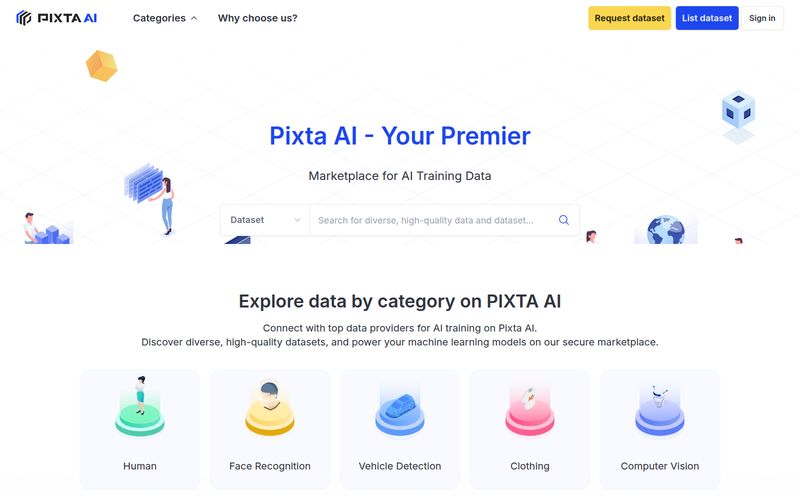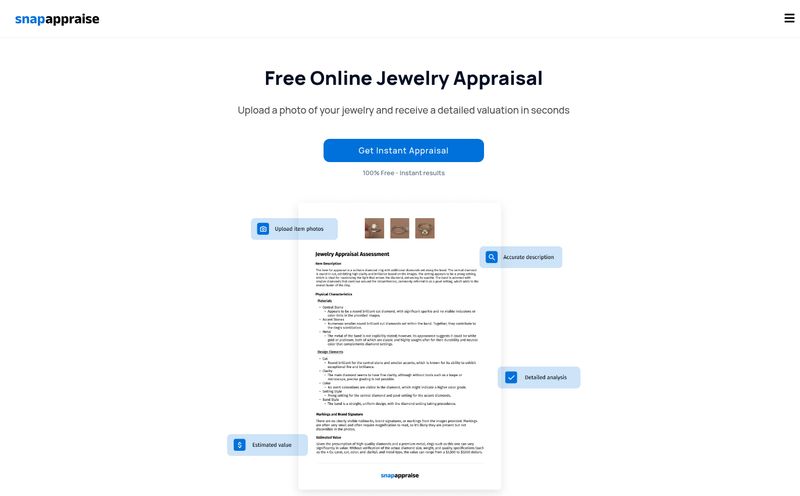The internet is getting… weird. One minute you're scrolling through your feed, laughing at a cat video, and the next you’re staring at a picture of, I don’t know, Elon Musk as a Roman emperor, and for a split second, you actually wonder. Did he do that? Is that real? Remember the Pope in the Balenciaga-style puffer jacket? We all fell for that one for a hot minute.
That’s the world we live in now. AI image generation has gone from a nerdy niche to a full-blown mainstream phenomenon, and frankly, it's getting harder and harder to tell the fakes from the photographs. As an SEO guy who lives and breathes digital content, this stuff is both fascinating and a little terrifying. The potential for misinformation and, more pointedly, scams, is huge.
So when I stumbled upon a tool called DeepfakeScam, my curiosity was definitely piqued. A free, simple, drag-and-drop tool that claims to sniff out AI-generated images? Okay, you have my attention. I had to see if it was just another gimmick or a genuinely useful tool for the average person. So I spent some time with it, and here’s what I found.
So, What Exactly Is DeepfakeScam?
In a nutshell, DeepfakeScam is a free web-based tool built for one single purpose: to tell you if an image was made by a human with a camera or a computer with an algorithm. You don't need to download anything, you don't need to sign up for a newsletter you’ll never read, and you don’t need to be a tech wizard to use it. Its mission is pretty noble—helping people protect themselves from the rising tide of AI-generated scams by providing a quick authenticity check.
Think of it as a pocket-sized lie detector for the pictures you see online. It’s designed to be that first, simple step you take before you share that outrageous political photo or, more importantly, before you trust an image in a message from a supposed “long-lost relative” who suddenly needs gift cards.
Getting Started Is Ridiculously Easy
I’m not kidding when I say it’s simple. The creators clearly wanted zero barriers to entry. Here’s the entire process:
- You find an image you're suspicious about.
- You go to their website.
- You either drag the image file directly onto the page or click to upload it from your computer.
That's it. A few seconds later, it gives you its verdict. No fuss, no muss. It's the kind of streamlined experience I wish more tools would adopt. We're all busy, right? I don’t have time for a 12-step verification process just to check a single photo.

Visit DeepfakeScam
The Good, The Bad, and The AI-Generated
No tool is perfect, especially not a free one. So let's break down where DeepfakeScam shines and where it stumbles a bit. I’ve been in this industry long enough to know that every shiny new toy has its quirks.
What I Genuinely Liked
The biggest pro is right there in the price tag: it's free. In a world of subscriptions and premium tiers, “free” is a beautiful word. This makes it accessible to absolutely everyone, from your skeptical uncle to a student working on a research project. The drag-and-drop interface is also a massive win for user experience. It’s intuitive. It just works. The core value proposition—providing a quick, easy shield against AI scams—is something I can really get behind. It’s a practical solution to a very modern problem.
Where It Could Be Better
Now for the reality check. The tool has some limitations you need to be aware of. It's not a magic bullet. The site itself notes that accuracy can dip when you use screenshots. This is a bit of a bummer, since most of the weird images we encounter are found on social media, and screenshotting is the easiest way to grab them. My guess is that the compression and extra artifacts from a screenshot can muddy the waters for the detection algorithm. It’s like trying to identify a bird call in the middle of a rock concert—the background noise gets in the way.
There are also some technical caps: images can't be larger than 8MB or 10,000x10,000 pixels. For most web images, this is fine, but it's something to remember if you’re trying to analyze a high-resolution professional shot. Finally, its accuracy isn't 100%. The quality of the detection can depend on which AI model was used to create the image (Midjourney, DALL-E 3, etc.). Some are trickier to spot than others. So, you should treat its result as a very strong suggestion, not as infallible gospel.
Why We Even Need Tools Like This
Some people might roll their eyes. “Can’t you just tell if an image is fake?” A few years ago, maybe. You could look for weird hands or wonky backgrounds. But the tech is getting scarily good. We're moving beyond funny memes and into a territory where AI images are used for fake news, political propaganda, and sophisticated financial scams.
I’ve seen reports from cybersecurity experts at places like Malwarebytes detailing how scammers are using AI to create convincing fake profiles and scenarios. A tool like DeepfakeScam acts as a first line of defense. It empowers the average user to pause and verify, which is a critical skill for digital literacy in 2024.
The Big Question: Does It Actually Work?
I threw a few test images at it. I took a real photo of my dog, a picture of a coffee I took this morning, and a few AI images I generated myself—a cat wearing a tiny astronaut helmet, a hyper-realistic portrait of a person who doesn't exist. For the most part, it did pretty well!
It correctly identified my real photos as, well, real. It also flagged my AI-generated images as likely AI. I did manage to trip it up once with a heavily edited, low-resolution AI image, which it was unsure about. This just confirms my earlier point: it’s a great guide, but you still need to bring your own critical thinking to the table. It's a tool, not an oracle.
Frequently Asked Questions About DeepfakeScam
1. Is DeepfakeScam really 100% free to use?
Yep. As of right now, it’s completely free. No hidden fees, no credit card required. Just upload and check.
2. What are the limits on the images I can check?
Your image file needs to be 8MB or smaller, with dimensions no larger than 10,000 by 10,000 pixels. This covers most images you’ll find on teh web.
3. How accurate is the detection?
It's pretty good, but not foolproof. Its accuracy can vary depending on how the AI image was made and if you're using a compressed screenshot. Think of it as a highly reliable but not infallible expert.
4. Why is it less accurate with screenshots?
Screenshots add new layers of pixels and compression that weren't in the original image. This can confuse the algorithm, which is trained to look for specific digital fingerprints left by AI generators. It’s like trying to analyze a photocopy of a photocopy.
5. Do I need to install any software to use it?
Nope. It’s a fully browser-based tool. You just need an internet connection and a web browser like Chrome, Firefox, or Safari.
My Final Verdict
So, is DeepfakeScam worth your time? Absolutely. It’s a simple, free, and effective tool that addresses a real and growing problem. It’s not a perfect, all-seeing eye, but it doesn’t claim to be. It’s a practical first-step verification tool that can give you a solid indication of whether an image is authentic or not.
In the ongoing cat-and-mouse game between content creators and content fakers, tools like this are incredibly valuable. It won’t solve the entire problem of digital misinformation, but it puts a little bit of power back into our hands. And in today’s weird, wild, and wonderful internet, a little bit of power goes a long way. Give it a try next time you see a picture that makes you go, “hmmm.”
Reference and Sources
- DeepfakeScam Official Website: deepfakescam.com (Assumed URL)
- Analysis of AI Scams: Malwarebytes - "A new wave of AI scams hits the internet"
- Viral AI Image Example: Wired - "The Pope in the Puffer Jacket Is a Sign of What’s to Come"



